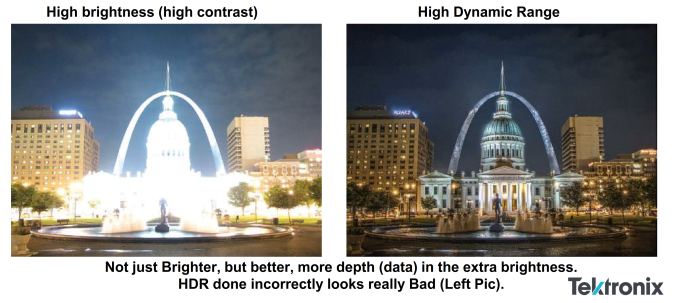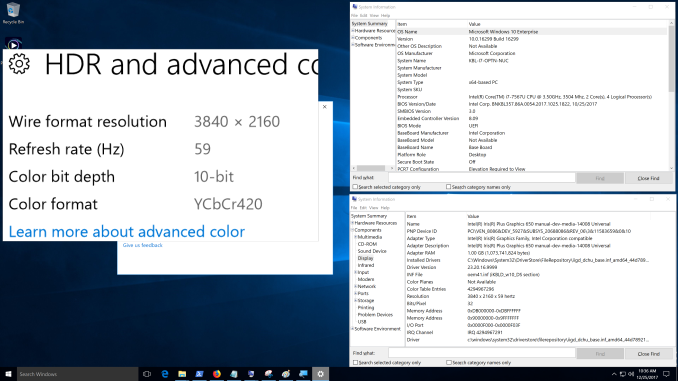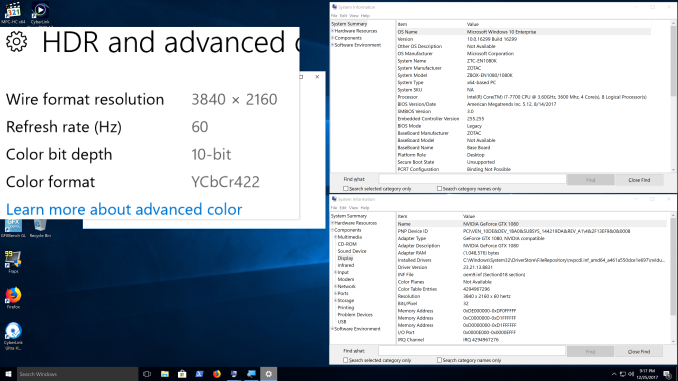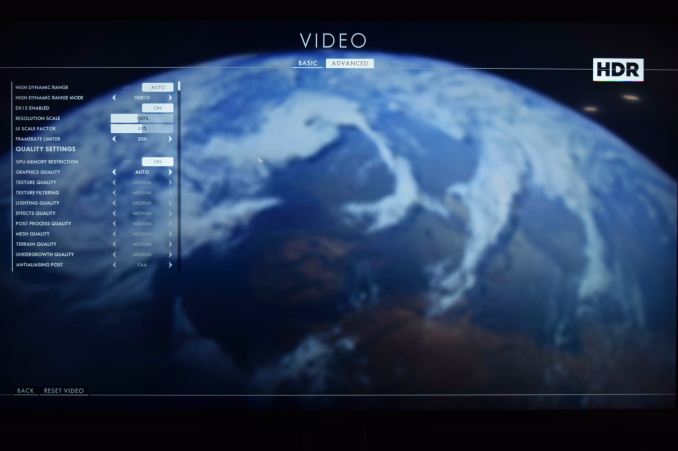A Budget Home Theater & PC Setup: 4K, HDR, UHD Blu-ray, and More
by Ganesh T S on December 26, 2017 8:30 AM ESTHDR Support
High Dynamic Range (HDR) is one of the most impressive features in the recent crop of 4K televisions. In layman's terms, it refers to the ability of a single frame to have wide variation in brightness for different regions. This allows the details in the dimly lit areas of the frame to be seen more clearly. Overall, it delivers a more vivid picture to the viewer. Note that this is quite different from the concept of high contrast.
Picture courtesy: SMPTE HDR Presentation from Steven Holmes of Tektronix
The ability of a display source to transmit HDR frames, as well as that of a display sink to be able to accept and understand them, can be gathered from the HDMI port's specifications. However, being able to accept and understand is only part of the problem. There are many low-cost 'fake HDR' TVs that simply parse the HDR information, but, do not have the ability to translate that to the display.
There are many HDR 'standards', with the base requirement being HDR10. Shifting a display sink into HDR mode involves the source sending some information (metadata) with the characteristics of the video being transported (the mapping of the pixel data to the displayed luminance, light levels in the video stream etc.). If this is static (i.e, done once when the shift to HDR mode occurs), it falls under the HDR10 category. Dolby Vision allows for the metadata to change on a frame-by-frame basis (dynamic). The upcoming HDR10+ standard will also support dynamic metadata. The takeaway is that Dolby Vision certification all but ensures a display with true HDR capabilities.
The TCL 55P607 comes with standard HDR10 and Dolby Vision support. The native Roku apps shift to the appropriate HDR mode based on the content being played back. We will analyze this more in the subsequent sections.
The NVIDIA SHIELD Android TV (SATV) is similar to the native Roku app in the TV with respect to treatment of HDR content. The main issue is that SATV doesn't support Dolby Vision yet, though there is a lot of clamor for it from SATV owners. Videos with HDR10 metadata shift the display to the appropriate HDR mode prior to playback.
PCs encounter additional challenges for HDR implementation. It is just not one company that is responsible for the feature. On one hand, the GPU driver vendors need to support it. On the other hand, the OS itself needs to provide hooks to enable HDR. Finally, the software ecosystem needs to catch up. The Windows 10 Fall Creators Update brought HDR10 capabilities for the Windows desktop into the stable ring. It also allowed streaming of HDR videos from YouTube and Netflix. Microsoft is continuing to fine-tune the HDR capabilities built into Windows 10.
Intel, along with CyberLink, had decided not to wait for Microsoft to deliver HDR on PCs. PowerDVD 17 was the first software Blu-ray player, and it only made sense for them to support HDR playback for applicable titles. The Intel / CyberLink solution for HDR when playing back certain Blu-rays in full-screen exclusive mode is orthogonal to Microsoft's HDR support.
The Windows 10 Fall Creators Update enabled desktop HDR and HDR video streaming on all the three test PCs described earlier.
HDR and Advanced Color Settings - Intel NUC7i7BNHX1 with Desktop HDR Enabled
The KBL-U platforms drove the display at YCbCr 4:2:0 10-bit, while the NVIDIA GTX 1080 drove the HDR output with higher quality (YCbCr 4:2:2 10-bit). For a good desktop experience, 4:4:4 is preferable.
HDR and Advanced Color Settings - Zotac ZBOX MAGNUS EN1080K with Desktop HDR Enabled
Gaming is not a focus in our HTPC reviews, but, we must give credit to NVIDIA for supporting Dolby Vision in their Pascal GPUs. Certain gaming titles such as Battlefield 1 support both HDR varieties (HDR10 and Dolby Vision), and the Zotac EN1080K is able to deliver it in a HTPC environment, thanks to its small form factor and relatively silent liquid cooling.
Battlefield 1 HDR Output from the Zotac EN1080K
Battlefield 1 Dolby Vision Output from the Zotac EN1080K
Unfortunately, Pascal's Dolby Vision support is available only in certain games, and is not applicable to streaming services like Netflix.
Microsoft's current approach to HDR with a desktop HDR mode is currently not efficiently implemented. For example, the desktop in the Zotac ZBOX MAGNUS EN1080K idles at 34.5W. With the HDR mode enabled, this jumps to 39.5W. In the KBL-U systems the penalty is of the order of 0.8W - 1W.















191 Comments
View All Comments
rapster - Sunday, December 31, 2017 - link
Definitely. My media cabinet alone was $3k and is the budget option compared to the built-in at my last house. I really don’t get the budget complaints unless we’re dealing with kids, and thought the piece addressed quite a few things that caused me grief. Wish I read it before my last build.ganeshts - Tuesday, December 26, 2017 - link
Most speakers were re-used from my previous setup, and as such, not a part of the initial purchase list. I assume most users who upgrade can reuse existing speakers. I provided a suggestion in the concluding section.NeatOman - Tuesday, December 26, 2017 - link
I'm still content with my current setup of a plasma connected via HDMI 4:4:4 and true 8-bit to a Pentium G6950/H57/4GB w/60GB SSD that's as quiet as a cat fart. The sound IMO hasn't improved much at all unless you are going full ATMOS, my 10+ year old setup is "limited" by 5.1 96k/24-bit audio :-/ (limited by the human ear as well lol) and the speakers (that cost under a few hundred dollars) haven't really gotten any better in the last 10+ years despite what people claim (marginal at best).Plasma still has better colors than the newest quantum/nando/hyper whatever LCD/LED TV's, although due to light/color bleed either from the panel itself or just having the lights on it's blacks aren't as good on my 6+ year old Plasma. And since i only use it for movies there still isn't any noticable burn in.
But I'm definitely going to replace the PC with something Intel powered that can handle HDR10 and 4K streaming (DRM) that i believe is anything iX-7xxx and up when i get a proper OLED TV.
beisat - Tuesday, December 26, 2017 - link
Netflix on PC is never 24p - neither on Edge nor UWP App...just keep that in mind if you ever consider using a htpc on a tv...Orange14 - Tuesday, December 26, 2017 - link
I agree with others as to some of these setups not qualifying as budget HTPCs. In addition, the major fault is to assume that nobody runs cablecard tuners anymore. In my case, I still watch a fair amount of sports that requires such a set up. I've been building my own HTPCs for over five years now in a variety of different configurations. Unless one really needs the setup for gaming, the hardware requirements are modest.euskalzabe - Tuesday, December 26, 2017 - link
I'm so surprised to not even see a mention of Windows 10's horrendous HDR support. I use a HDR10 supporting TV as a monitor, with a GTX 1060, and the second I enable HDR on the desktop everything looks awfully washed out. Many have commented on this problem online forums. Sadly HDR on Windows 10 is, currently, unusable.Aikouka - Wednesday, December 27, 2017 - link
If you enable HDR in the resolution options in Windows, it will leave HDR on *at all times*. The problem is that it makes *no attempts* to adjust the content. So, it will effectively display SDR content in HDR, which doesn't turn out well. Although, I didn't notice nearly as many issues on my Sony TV as I did on my TCL TV (the Best Buy variant of the one in the this article, the P605). I wonder if that's due to the Sony TV's features including adjusting SDR content to try to make it look more like HDR?reiggin - Tuesday, December 26, 2017 - link
Not to pile on for the sake of piling on, but as others have said, this article just doesn't meet the stated objective of the headline. It's not a budget setup. It actually fails on two points -- it's neither "budget" nor "setup." To imply that it is a setup would imply that it's fully baked out. It's missing several crucial pieces of info on the speakers/audio quality (only noting the receiver and a set of surrounds is missing so much detail). And it's also missing basic details on how the whole system is configured, intended use, impressions other than technical ones, etc.All in all, this article really disappoints. It's subpar on the quality I've come to expect from Anandtech. There are glaring typos throughout that should be caught with a basic spell check. The structure of the article itself seems to bounce around. Heck, even the introductory first page just seems to be a hot mess.
I think in the end the best (admittedly unsolicited) advice that I could give is to just leave the home theater reviews to AVSForums or some other more experienced site and instead stick to reviews of individual hardware components.
Chyll2 - Tuesday, December 26, 2017 - link
Subpar article. I rather see this in a personal blog not in this site. One of the worst "budget" article I saw in a whilemr_tawan - Tuesday, December 26, 2017 - link
On the HTPC front, I guess you went for Core i5 HTPC just for SGX that's required by PowerDVD. It looks like all 7th gen Core CPU supports SGX (unlike Skylake which the lower bound is Core i5), so maybe Core i3 NUC works as well in this regard?